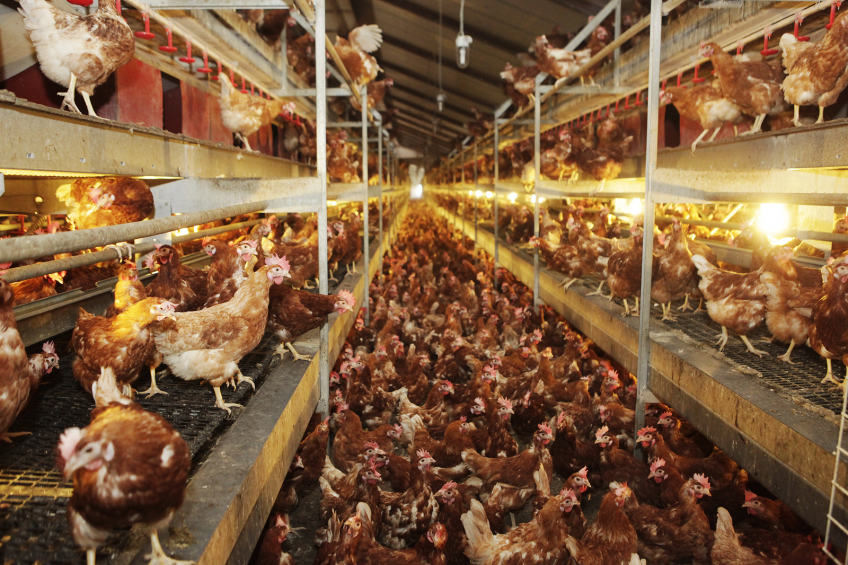Disinfection during lay keeps birds healthy

Disinfection of the poultry house is normally carried out between rounds. Within the production cycle the options to tackle micro-organisms are limited, especially during the long cycles in laying. Disinfection during lay is a viable option to keep birds healthy.
Layers face all kinds of harmful bacteria and diseases during their life. Starting a production cycle with a super clean house, cannot always prevent problems caused by coccidian, Salmonella, campylobacter, clostridium and others. On top of that poultry farming very often faces antibiotic resistant strains of micro-organisms. The need of additional treatments increases too, mainly for performance stimulation with vitamins, micro, macronutrients, and other feed additives.
To battle the increased and unregulated application of antibiotics and the subsequent sharp increase in antibiotic resistance of the micro-organisms on the one hand and the significant increase of food safety criteria on the other lead to the inclusion of strict rules for antibiotic use and residues in chicken meat and eggs. With this regard Stalosan F, produced by Stormoellen – part of Vilofoss Group, Denmark was tested in a laying hen farm, during a production cycle. The product gave farmers the opportunity to control of a broad spectrum pathogens – bacteria, viruses, fungi and the fly population with an exceptional activity in the presence of organic matter. Furthermore have a significant positive impact on environmental conditions by neutralising ammonia and hydrogen sulphide as well as moisture in the litter in poultry houses. In this way Stalosan F plays a significant role in biosecurity, animal welfare, providing round the clock protection against diseases during the whole production cycle.
Farm with a problem
A field experiment on an egg producing farm was conducted to get the farmer out of a negative spiral. The farm had encountered multiple challenges and undertook efforts to battle them one by one. The main problem was an increased mortality. From the beginning of the year high mortality was observed. Lab tests isolated E. coli O78. Based on the test, two antibiotics were administrated, Enrofloxacin and combination of Enrofloxacin + Colistin followed by vitamins. However, the efficacy of the treatment reduced mortality for about 10-14 days, then it returned high again. This continued throughout the period (about 4.5 months) before starting, the use of Stalosan F powder. On top of that the flock battled with a persistent parasitic infection with Ascaridia gali. The farmer periodically applied Vermitan premix for 5 days in the feed as a treatment against parasites.
Quality of the feed was also tested. Poor quality sunflower meal was found. Immediately the meal was replaced with a better quality and inclusion rate reduced from 8% to 4%. However, the change did not affect mortality. Another stress factor was the infestation of the litter with mealy mites. On the upside; water was also tested and showed it meets the standards for human consumption. Water treatment began with organic acid mixture for additional sanitation of drinking lines and tanks and improvement of bird’s digestive system. This treatment did not show any results.
Stalosan F application
After the antibiotic treatment for 5 days Stalosan F application started. It was applied for the first 3 days and once per week later on for a period of 10 weeks. The product was spread across the entire floor area, especially in wet and damp areas as well as along the edges of the house. Total quantity used was 500 kg for 12 applications at 50 gr/m². The birds showed an immediate response. The mortality decreased significantly without any antibiotic treatments or other medication, egg production performance increased and litter quality improved. There was a significant reduction of fly and mealy mite population and consequently there was no reoccurrence of E.Coli infection, thus no need of antibiotic treatments. In fact all additional treatments were terminated such as deworming, water treatments and BioZink medication. Stalosan F application helped to minimise the production cost.
Key role in biosecurity
The use of Stalosan F during the production solves infection problems and blocks the development of antibiotic resistant bacteria. It plays a key role in maintaining the health status of the birds and the ability of hens to overcome more easily the stress. It also shows a significant impact on animal welfare. The Stalosan F application showed its efficacy, which can be used for disease prevention and its safety for the birds and equipment. Birds showed adequate response to Stalosan F treatment and the conclusion is, that it is a product of choice needed to optimise their life comfort. Additionally Stalosan F can be considered as a product which helps poultry to overcome more easily the stress situations. Stalosan F plays a key role for the poultry farm biosecurity, directly linked to the animal health and welfare, capable to reduce antibiotic treatments, as well as additional stimulating treatments.












